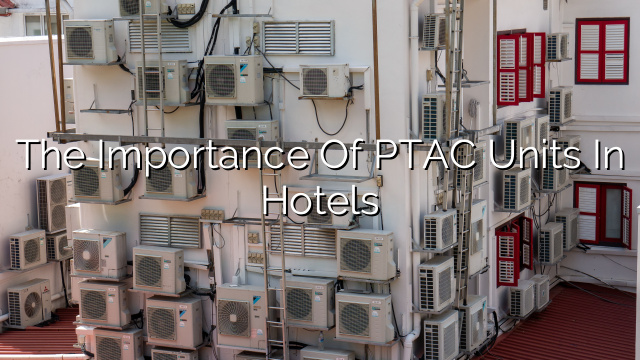FAQ
What are PTAC units?
PTAC stands for Packaged Terminal Air Conditioner. These units are often seen in hotels and motels, where they provide heating and cooling to individual rooms. PTAC units are self-contained and are typically installed through a wall or a window.
How do PTAC units work?
PTAC units work by drawing in fresh air from outside, passing it through a filter to remove any impurities, and then conditioning the air to the desired temperature. The conditioned air is then blown into the room, while the exhaust air is expelled outside through another vent. Most PTAC units are controlled using a thermostat that allows the occupants to set the desired temperature.
Advantages of PTAC units
- Individualized control: One of the main advantages of PTAC units is that they provide individual control to each room. This means that occupants can set the temperature to their liking without affecting the rest of the building. This is especially useful in hotels where different guests may have different temperature preferences.
- Energy Efficiency: PTAC units are known for their energy efficiency. They operate on a cyclical basis, which means that they only run when they need to, saving energy in the process. Some modern PTAC units also come with energy-saving features such as sleep mode or occupancy sensors.
- Easy installation: PTAC units are relatively easy to install. They can be mounted through a wall or a window, depending on the building’s configuration. This makes them a cost-effective option for both new buildings and renovations.
- Low maintenance: PTAC units require minimal maintenance. Regular cleaning of the filters and the occasional inspection by a professional are usually sufficient to keep them running smoothly. This saves both time and money in the long run.
- Cost-effective: Compared to central air conditioning systems, PTAC units are more cost-effective, especially in smaller buildings. They have a lower upfront cost and can be easily replaced if needed.
Disadvantages of PTAC units
- Noisy operation: PTAC units can be noisy, especially older models. The sound of the fan or compressor running can be disruptive, especially in quiet environments. However, newer models are designed to be quieter and some even come with noise-reducing features.
- Limited capacity: PTAC units are typically designed to cool or heat one room at a time. This means that they may not be suitable for larger spaces or buildings that require zonal control. In such cases, a central air conditioning system may be a better option.
- Less aesthetically pleasing: PTAC units can be less aesthetically pleasing compared to other cooling solutions like split air conditioning systems. The visible unit on the wall or window may not fit the overall design of the room, which can be a drawback for some people.
- Space limitations: PTAC units require space on the wall or window for installation. This can be a challenge in buildings with limited wall or window space. In such cases, alternative cooling solutions may need to be considered.
Considerations when choosing a PTAC unit
- Size: It is important to choose a PTAC unit of the right size for the room or space it will be installed in. An undersized unit may struggle to cool or heat the room adequately, while an oversized unit may cycle on and off too frequently, leading to increased energy consumption and discomfort.
- Energy efficiency: Look for PTAC units with high energy efficiency ratings. Energy Star certified units are a good choice as they are tested and proven to be energy-efficient.
- Noise levels: Consider the noise levels of the PTAC unit, especially if it will be installed in a quiet environment such as a bedroom or a study. Look for models that have noise-reducing features or are known for their quiet operation.
- Installation requirements: Determine whether the building has the necessary infrastructure to support PTAC units, such as electrical outlets and space for installation. Consulting with a professional HVAC technician can help ensure a smooth installation process.
- Warranty and maintenance: Check the warranty and maintenance requirements of the PTAC unit. It is important to understand what is covered under the warranty and what kind of maintenance the unit will require to keep it running efficiently.
Conclusion
PTAC units are an efficient and cost-effective solution for providing heating and cooling to individual rooms. They offer individual control, energy efficiency, easy installation, and low maintenance. However, they can be noisy, have limited capacity, and may not be aesthetically pleasing for some. When choosing a PTAC unit, consider factors such as size, energy efficiency, noise levels, installation requirements, and warranty and maintenance. Overall, PTAC units are a popular choice for hotels and motels, but they may not be suitable for larger spaces or buildings that require zonal control.














